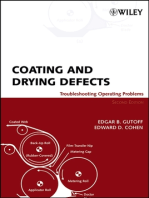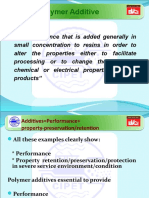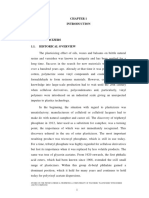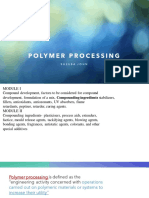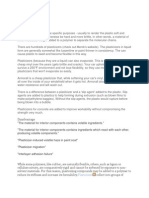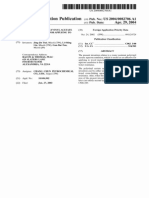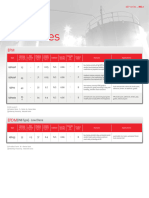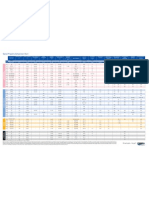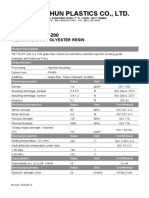100%(1)100% found this document useful (1 vote)
374 viewsEastman Benzoate Article
Eastman Benzoate Article
Uploaded by
zlightyearThis document reviews the value propositions provided by benzoate plasticizers in adhesive and sealant formulations, primarily focusing on waterborne systems. Benzoate plasticizers offer compatibility with many polymers used in adhesives and sealants and provide benefits like improved low temperature properties and adhesion. The main applications for plasticized adhesives and sealants are identified as well as processes for selecting a suitable plasticizer.
Copyright:
© All Rights Reserved
Available Formats
Download as PDF, TXT or read online from Scribd
Eastman Benzoate Article
Eastman Benzoate Article
Uploaded by
zlightyear100%(1)100% found this document useful (1 vote)
374 views13 pagesThis document reviews the value propositions provided by benzoate plasticizers in adhesive and sealant formulations, primarily focusing on waterborne systems. Benzoate plasticizers offer compatibility with many polymers used in adhesives and sealants and provide benefits like improved low temperature properties and adhesion. The main applications for plasticized adhesives and sealants are identified as well as processes for selecting a suitable plasticizer.
Original Description:
Benzoate
Copyright
© © All Rights Reserved
Available Formats
PDF, TXT or read online from Scribd
Share this document
Did you find this document useful?
Is this content inappropriate?
This document reviews the value propositions provided by benzoate plasticizers in adhesive and sealant formulations, primarily focusing on waterborne systems. Benzoate plasticizers offer compatibility with many polymers used in adhesives and sealants and provide benefits like improved low temperature properties and adhesion. The main applications for plasticized adhesives and sealants are identified as well as processes for selecting a suitable plasticizer.
Copyright:
© All Rights Reserved
Available Formats
Download as PDF, TXT or read online from Scribd
Download as pdf or txt
100%(1)100% found this document useful (1 vote)
374 views13 pagesEastman Benzoate Article
Eastman Benzoate Article
Uploaded by
zlightyearThis document reviews the value propositions provided by benzoate plasticizers in adhesive and sealant formulations, primarily focusing on waterborne systems. Benzoate plasticizers offer compatibility with many polymers used in adhesives and sealants and provide benefits like improved low temperature properties and adhesion. The main applications for plasticized adhesives and sealants are identified as well as processes for selecting a suitable plasticizer.
Copyright:
© All Rights Reserved
Available Formats
Download as PDF, TXT or read online from Scribd
Download as pdf or txt
You are on page 1of 13
Non-Phthalate Benzoate Plasticizers
Do More than Just Plasticize
Edward M. Petrie
EMP Solutions
Cary, NC
Keywords: Plasticizers, benzoates, adhesives, sealants, waterborne, hot melt, volatility, migration,
adhesion, glass transition temperature, compatibility.
Summary: This article reviews the various value propositions provided by benzoate plasticizers in
adhesive and sealant formulations. It primarily focuses on waterborne systems, but opportunities in other
product forms are also noted. The main applications for plasticized adhesives and sealants are identified
as well as processes for selecting and evaluating a suitable plasticizer.
Introduction
Plasticizers are used in all types of adhesive and sealant formulations: waterborne, hot melt, solvent
based, and 100% solids reactive. They are used primarily to flexibilize the final product and provide
improved low temperature resistance. However, plasticizers can also provide additional benefits that are
important to the formulator and end-user. Table 1 summarizes the main functions performed by
plasticizers in adhesive and sealant formulations.
Table 1 Function of Plasticizers in Adhesives and Sealants
Function Solvent
Based
Water-
borne
Hot Melt 100%
Solids
PVC
Plastisol
Soften, decrease modulus, decrease Tg,
improve low temperature properties
Increase solids content
Replace co-solvents
Improve adhesion, tack, and heat sealing
temperature
Modify viscosity (+ and -), liquid adhesives
Reduce melt viscosity, hot melt adhesives
Improve coatability
Extend open time and reduce set time
Improve processing characteristics
Lower gelation / fusion temperature
Improve paintability
Over the years, benzoate esters have proven to be excellent plasticizers for adhesives and sealants of all
types and have especially claimed fame as non-phthalate plasticizers for waterborne latex systems.
Benzoates were introduced as polyvinyl chloride (PVC) plasticizers in the 1990s. Although today the
largest application area for these plasticizers is in adhesives and sealants (Figure 1), demand for
benzoates in PVC applications is growing very rapidly.
Eastman Chemical Company is one of the leading global suppliers of non-phthalate plasticizers. In 2010
Eastman acquired Genovique Specialties Corporation, an important supplier of benzoate plasticizers.
Table 2 provides a description of Eastmans product offerings and related applications. The Appendix
summarizes the technical features for these benzoate plasticizers.
This article reviews the various value propositions provided by benzoate plasticizers in adhesive and
sealant formulations. The focus is on waterborne systems, but opportunities in other product forms are
also noted. The main applications for plasticized adhesives and sealants are identified, as well as
processes for selecting and evaluating a suitable plasticizer.
Figure 1 US consumption of benzoate plasticizers.
1
1
Plasticizers, Chemical Economics Handbook, IHS Chemical, November 2009.
Table 2 Non-Phthalate Eastman Plasticizers for the Adhesives and Sealants Market
2
Types of Plasticizers and End-Use Applications
The following applications prominently use plasticized adhesives and sealant formulations, but this list is
not exhaustive.
Packaging carton sealing (waterborne emulsions)
Automotive adhesives and sealants
Construction adhesives and sealants decorative wall panels, flooring, window glazing, caulks
Bookbinding (hot melt adhesives)
Tapes and labels (pressure sensitive adhesives)
Textiles nonwoven fabrics and fibers (hot melt and waterborne emulsions)
The use of plasticizers is very common in adhesives and sealants, but they are used in lower
concentrations than in plastics or elastomers. Plastisol and cohesively removable pressure sensitive
adhesive products are exceptions as they require high concentrations of plasticizers for the conditions of
their performance.
A large number of different resins and, thus, a large number of plasticizers are used in adhesives and
sealants. Different plasticizers affect different physical and chemical properties of materials. There are
over 38 general chemical families of plasticizers that are used for polymer modification.
3
The major
2
Eastman Flexible Solutions for Strong Brands, Publication L-249, Eastman Chemical Company, April 2012.
3
Wypych, G., Plasticizer Types, Chapter 2 in Handbook of Plasticizers, Wypych, G., ed., William Andrew
Publishers, New York, 2004.
chemical classes are listed in Table 3. Products may also use blends of plasticizers to achieve the
desired end properties.
Table 3 Chemical Classes of Selected Plasticizers
Phthalates
Benzoates
Terephthalates
Adipates
Azelates
Trimellitates
Sulfonamides
Polyesters
Sebacates
Citrates
Epoxy oils
Soy and other oil
derivatives
Glycol ethers and
esters
Hydrocarbons
Oils (paraffinic,
naphthenic, and
aromatic)
Phosphates
Ethers
Glutarates
Terpenes
Pentaerythritol
esters
Ricinoleates
Isobutyrates
Historically, phthalates have been the most popular choice of plasticizer because they usually provide the
best all-around performance (especially in flexibilizing PVC) and they are low in cost. However,
phthalates have come under increasing regulatory and consumer scrutiny due to their migration potential
and concern regarding their toxicity, safety, and environmental burden.
Non-phthalate plasticizers, such as benzoates, terephthalates, citrates, sulfonamides, and polymeric
plasticizers, have begun replacing many of the phthalates due to regulatory and toxicological concerns.
Regulatory changes and shifting consumer preferences are driving rising demand for non-phthalate
alternatives in the USD $12+ billion global plasticizer market. Demand for non-phthalate alternatives is
expected to grow at a compounded annual rate of 7% over the next five years in North America and
Europe.
Some adhesives and sealants demand plasticizers with special characteristics. For example, the use of
solid or high boiling point liquid plasticizers is generally required for hot melt adhesives. The plasticizer
should melt just below the temperature of application but revert to solid form after the bond is formed.
Reactive adhesive and sealants may also require high boiling point plasticizers because these products
are often cured at elevated temperatures.
On the other hand, waterborne adhesives require the use of liquid plasticizers that can be easily
dispersed in water. Even though the plasticizer may be relatively insoluble in water, it is easily absorbed
by the particles of the polymer emulsion, allowing for easy compounding.
While there are many types of plasticizers, there are relatively few for waterborne adhesives. This is an
application where benzoates have a commercial and technical edge. Although other plasticizers are
often used in waterborne adhesive and sealant formulations, benzoates appear to offer an optimal
balance of performance and value.
Benzoate plasticizers are relatively polar which allows compatibility with many polymers that are used in
formulating emulsions, hot melts, solvent, and reactive adhesives and sealants. Common base polymers
that are compatible with benzoate plasticizers and their end-use applications are indicated in Table 4.
Table 4 Common Polymers in Adhesive and Sealant Formulations Compatible with Benzoate Plasticizers
Polymer Abbreviation Primary Adhesive Form End-Use
Polyvinyl acetate PVAc Waterborne Woodworking, packaging
Vinyl acetate ethylene VAE Waterborne Woodworking, laminating films
Ethylene vinyl acetate EVA Hot melt Packaging
Polyvinyl chloride PVC Plastisol Sealant (auto)
Styrene butadiene rubber SBR Waterborne and solvent Sealant (construction)
Ethyl cellulose EC Solvent Solvent cement for plastics
Nitrocellulose NC Solvent Solvent cement for plastics
Cellulose acetate butyrate CAB Solvent Solvent cement for plastics
Polyurethane PU Reactive, waterborne, solvent Sealant (construction), structural
adhesive
Polysulfide PS Reactive Sealant (aircraft, auto)
Acrylic PMMA Waterborne and solvent Packaging, tapes and labels,
sealants (construction)
Benzoate plasticizers include benzoates, dibenzoates, or any mixture thereof. Typical benzoate and
dibenzoate chemical structures are illustrated in Figure 2. Property ranges for the benzoate group of
plasticizers compared to the phthalate group is provided in Table 5. Generally, the properties of these
plasticizer families are comparable except for freezing point and solubility in wat er (favorable to
benzoates). There is some difference on weight loss during heating that also favors the benzoates.
Figure 2 Chemical structures of benzoate and dibenzoate.
Table 5 Property Range (low to high unless otherwise given) for
Benzoate and Phthalate Plasticizer Families
4
Property Benzoates Phthalates
Molecular weight, daltons 178 - 1175 194 - 530
Freezing point, C -38 (low) -67 (low)
Boiling point, C 249 - 323 283 - 523
Flash point, C 148 - 258 146 - 254
Refractive index at 20C 1.49 - 1.569 1.481 - 1.515
Vapor pressure, kPa (minimum) 2.5X10
-8
at 25C 3.0x10
-8
at 100C
Solubility in water at 25C, weight % 3.04x10
-5
- 2.08x10
-3
3.0x10
-7
- 1.2x10
-3
Viscosity, MPa-s 15 - 406 at 25C 11- 320 at 20C
Surface tension at 20C, mN/m (median) 40.4 33
Weight loss at 87C, 24 hrs, weight % 1.2 - 11.5 0.8 - 31
4
Wypych, G., Handbook of Plasticizers, Wypych, G., ed., William Andrew Publishers, New York, 2004.
Benzoates have replaced much of the C
4
phthalate previously used in emulsion coatings and adhesives
(e.g., PVAc and acrylic). Certain performance characteristics, other than being a non-phthalate
alternative, have produced a high level of interest in benzoate plasticizers. These added value
propositions are shown in Table 6.
Table 6 Potential Value Propositions Offered by Benzoate Plasticizers
Property Improvements Processing Improvements Other
Low temperature properties
UV / light resistance
Tensile and tear strength
improvement
Low volatility, migration
resistant
Resistance to extraction by
solvents, oils, etc.
Increased open times and
reduced set times (waterborne
and hot melt adhesives)
Improved adhesion
High degree of compatibility
Significant viscosity response
High solvating power, fast fusion,
and good gelation properties
High boiling point
Both solid and liquid types
available
Decreased processing time
Good coalescing agent
Possible tackifier or wax
replacement
Elimination of risk labeling
Direct food contact approval
Low VOCs
Regulatory compliance
(REACH, ECHA, etc.)
Possible cost reduction
(relative to base polymer)
Environmental and regulatory factors have been the driving force for the introduction and growth of
benzoate and other non-phthalate plasticizers. Beyond their health and environmental benefits, the
benzoate plasticizers have proven to offer equivalent performance to their phthalate counterparts in many
applications. To be considered as alternatives to general purpose phthalates, plasticizers must provide at
least one of the following value propositions beyond being non-phthalate:
Reduced price
Improved performance / processing
Improved regulatory compliance (safety, health, environmental).
Price and Formulation Cost
Formulators are often reluctant to begin the costly and time consuming process of reoptimizing their
formulations for a new plasticizer for the following reasons.
Higher price of non-phthalate plasticizers (although future prices are claimed to come down with
volume and technology improvements) -- Prices are highly dependent upon raw material costs.
Benzoate plasticizers utilizing toluene as a raw material are currently more costly than phthalate
plasticizers which are based on phthalic acid.
Availability (global availability is necessary in many high volume industries such as packaging) --
However, lack of availability is often more of a perception than reality. Recent years have seen
increases in production capacities of nearly all non-phthalate plasticizers around the globe.
Not being a drop-in replacement (reformulation and revalidation is likely in order to maintain
current properties) -- Non-phthalate plasticizers can have properties that differ from phthalates,
with some properties being superior to their phthalate counterparts. The amount of reformulation
necessary will depend on how tight the specificat ions for performance are and how closely the
non-phthalate replacement mimics the properties of the plasticizer it is replacing.
Plasticizers that are produced in high volume, such as general purpose phthalates, have a manufacturing
advantage over more specialty non-phthalate plasticizers simply due to the economies of scale generated
by producing larger volumes of product. Most non-phthalate plasticizers, including benzoates, are more
expensive than phthalate plasticizers, and this is certainly a detriment to their usage especially in
applications that are not heavily regulated.
Plasticizer price factors may be mitigated by formulation and processing advantages. For example, when
added to emulsion systems, plasticizer addition generally increases viscosity. This can allow improved
coating and build and workability in certain applications without having to increase the concentration of
the base polymer. Without using plasticizers, a converter would have to revert to using an emulsion
having higher solids content (and higher cost) to achieve high coating builds.
Most plasticizers are manufactured from petrochemical feedstock, resulting in significant increases in
price and price volatility over the last several years. Biobased plasticizers (e.g., soy based) may prove to
be less expensive in the long run due to the fact that they are manufactured from renewable feedstock ,
but this has not yet been the case. Biobased plasticizers have only recently been commercialized and
have not yet shown that they have comparable performance to other non-phthalate plasticizers based on
different chemistries.
Performance / Processing
Compatibility
Plasticizer compatibility is the key to plasticizer performance in adhesives and sealants. In latex systems,
compatibility can be assessed by observing the viscosity increase after the addition of the plasticizer and
by observing the clarity of a cast film of the plasticized adhesives. A compatible plasticizer will give a
greater viscosity response and will provide a clear dry film.
One of the main attributes of benzoate plasticizers is their good compatibility with many polymeric resins
as was indicated previously in Table 4. This is due to their higher solubility and polar nature. With
respect to compatibility, benzoate plasticizers are considered to be at least equivalent to the BBP, DEHP,
and other regulated phthalate plasticizers.
Benzoate plasticizers are popular in latex formulations which are common in the adhesive and sealant
sectors. They have excellent compatibility with common polymeric emulsions such as polyvinyl acetate
(PVAc), vinyl acetate ethylene (VAE), and acrylic.
Viscosity Response
Viscosity response is a key evaluation parameter in choosing a plasticizer. The addition of certain
plasticizers to a polymeric emulsion will result in increased viscosity. This effect can be used to formulate
a waterborne adhesive having greater coating thickness build-up. When higher viscosity is not required
the thickened emulsions are cut back to a specified constant viscosity, resulting in cost savings.
The degree of viscosity response is also a predictor of compatibility (i.e., the greater the viscosity
response the greater the compatibility). Figure 3 illustrates the viscosity response of several benzoate
plasticizers compared to conventional phthalate plasticizers such as dibutyl phthalate (DBP), diisobutyl
phthalate (DIBP), and butyl benzoate phthalate (BBP).
Figure 3 Polyvinyl acetate homopolymer viscosity response after 24 hrs.
Glass Transition Temperature Suppression
Suppression of the glass transition temperature, Tg, is an important plasticizer function as the formulator
can use this to control many of the final properties of the adhesive or sealant (flexibility, low temperature
resistance, toughness, adhesion, etc.). Plasticizers that have a greater effect on the glass transition
temperature are considered to be more efficient and more compatible with the base polymer.
Tg suppression is used mainly to improve the flexibility, adhesion, and low temperature properties of
polyvinyl acetate homopolymers and vinyl acetate ethylene copolymers. Figure 4 illustrates the Tg
suppression of benzoate plasticizers compared to conventional phthalates in reducing the Tg of a
polyvinyl acetate homopolymer.
Figure 4 Tg Suppression of a polyvinyl acetate homopolymer.
Adhesion
Peel strength is often used as a measure of adhesion to a substrate. Flexible adhesives generally have
higher peel strength due to better distribution of stress and are preferred for flexible substrates such as
packaging films and foils. Figure 5 illustrates the 180 peel strength of benzoate- and phthalate-
plasticized polyvinyl acetate emulsions on a cloth substrate.
Figure 5 Peel strength (180 peel on dry cloth) of plasticized polyvinyl acetate homopolymer.
5
Tack is also an important property in pressure sensitive adhesives. Tack can simply be defined as the
resistance of a liquid or semi-solid to separation or the stickiness of the adhesive as noticed by finger-
touch. An important characteristic of plasticizers is the chemical compatibility with conventional tackifiers.
In pressure sensitive adhesive applications, benzoate plasticizers may provide additional value such as:
1. A cost reducer for tackified formulations without decreasing tack properties. For example,
dibenzyl or dicyclohexyl phthalate can act as both a plasticizer and a tackifying agent.
6
2. An additive to enhance the tack properties of tackifiers already present.
Set and Open Times
Plasticizers can significantly shorten the set time and ext end the open time for waterborne or hot melt
adhesives. Both effects are looked upon as improvements by the formulator as they are valued in many
end-use applications including packaging. Figure 6 shows the effect of benzoate and phthalate
plasticizers on the set and open times of a polyvinyl acetate homopolymer.
5
Arendt, W.D., Benzoflex LA-705: A New Global Plasticizer for Waterborne Adhesive Market, Adhesive and
Sealants Council Meeting, 2006.
6
Wake, W.C., Adhesion and the Formulation of Adhesives, Applied Science Publishers, London, 1976, p. 261.
Set time is the time required for the adhesive to provide a measurable degree of bond strength after
substrates are mated. Open time is the time that the adhesive can stand after being applied and before
the substrates are mated. Longer open times may be required for substrate adjustment or production
timing. Long open times are also indicative of good wet tack.
Figure 6 Effect of plasticizers on the set and open times of a polyvinyl acetate homopolymer.
Volatility and Migration
Volatility is typically a limiting factor for the use of many plasticizers. The fugitive nature of plasticizers is
important because of: (1) volatile loss during processing and the resulting necessity to increase plasticizer
concentration, (2) degradation of properties with time that the adhesive bond is in service, and (3)
volatility is an indication of VOCs. Benzoate plasticizers have exhibited lower volatility than DBP or other
phthalates (Figure 7.)
Figure 7 Plasticizer volatility per ASTM D2369 (weight loss after 1 hour at 110C).
7
Thermal gravimetric analysis (TGA) measures the volatiles lost in a plasticizer or adhesive formulation as
a function of time at temperature. This is important in estimating migration potential as well as safety /
toxicity issues. Many adhesives and coatings are processed at high temperatures (either during the
compounding process or during application and cure). A high degree of volatility would signal significant
loss of plasticizer during these processes, resulting in degraded final product. Volatility can be measured
in a standard thermal oven by ASTM D-2369 and this has become part of EPA-24.
Other Physical Property Improvements
Benzoate plasticizers also aid in the development of certain other physical properties. For example,
improvements have been noticed in tensile properties of benzoate-plasticized films compared to
conventional phthalate plasticizers. Diethylene glycol dibenzoate and triethylene glycol dibenzoate have
also been reported to be especially good in providing improved tear resistance.
Benzoate plasticizers are recognized to have good resistance to extraction by aliphatic solvents and oils.
This leads to their use in applications such as flooring and wall coverings, food packaging, and medical
devices. Benzoates also exhibit good environmental aging characteristics that are important for
adhesives and sealants used in graphic arts, construction, transportation, and other exposed applications.
The benzoates are claimed to have better UV light stability when compared to conventional phthalate
plasticizers.
7
Arendt, W.D., Benzoflex LA-705: A New Global Plasticizer for Waterborne Adhesive Market, Adhesive and
Sealants Council Meeting, 2006.
Regulatory Compliance
The European Chemicals Agency (ECHA) manages the pan-European chemical oversight program
REACH. The following phthalate plasticizers have been cited as substances of very high concern
(SVHC):
Benzyl butyl phthalate (BBP)
Di-(2-ethyl hexyl) phthalate (DEHP)
Dibutyl phthalate (DBP)
Diisobutyl phthalate (DIBP)
Pentyl iso-pentylphthalate (PIPP)
Diisopentylphthalate (DIPP)
Dimethoxyethylphthalate (DmoEP)
These chemistries have come under increased scrutiny under the REACH regulations because of their
toxicity data in some animal species coupled with wide use and high volumes. Of particular concern are
BBP, DBP, and DEHP, which have been targeted by ECHA for the authorization process in 2013.
Benzoate plasticizer chemistry has been identified by ECHA as a safer, viable alternative to phthalate
plasticizers.
8
For example, ECHA concluded that dipropylene glycol dibenzoate (Benzoflex 9-88) is
viewed more favorably than the other alternatives to BBP examined. And benzoate plasticizers are also
identified as potential alternatives for DBP and DEHP, showing the diversity of the benzoate chemistry in
these applications.
In the US, the Consumer Product Safety Commission Act of 2008, restricted the sale of toys and other
childrens products containing six specified phthalates.
Diisononyl phthalate (DINP)
Diisodecyl phthalate (DIDP)
Bis(2-ethylhexyl) phthalate (DEHP)
Dibutyl phthalate (DBP)
Benzyl butyl phthalate (BBP)
Di-n-octyl phthalate (DnOP)
This action mirrored regulation that had been introduced in Europe in 2005, when the European
Parliament restricted the use of those same phthalates in childrens toys. Subsequently, authorities from
several other countries have enacted similar regulations restricting these phthalates in childrens goods.
Due primarily to their high biodegradation rates and low toxicity, benzoate plasticizers have been
approved for various food packaging applications. For example, Eastmans Benzoflex LA-705 is
approved in the US for the following FDA food contact clearances:
21CRF175.105 (indirect food contact, adhesives),
21CRF176.170 (indirect food contact, components of paper and paperboard in contact with
aqueous foods), and
21CRF176.180 (indirect food contact, components of paper and paperboard in contact with dry
food).
8
Deligio, T., Phthalate Alternative Recognized by ECHA, http://mpw.plasticstoday.com/articles/phthalate-
alternative-recognized-echa.
Studies submitted to and reviewed by the EPA have not revealed risks to human health with benzoate
plasticizers. Benzoate plasticizers have been fully REACH registered and do not have any CLP labeling
requirements for human health. No benzoate plasticizers are on the Substances of Very High Concern
(SVHC) list, nor have any been nominated for Community Rolling Action Plan (CoRAP) evaluations,
which is the first step for identification of SVHCs.
Appendix: Description and Technical Features of Eastman Benzoate Plasticizers
Plasticizer Base Polymer Application Characteristics
Benzoflex 50 Polyvinyl acetate homopolymer and
copolymer adhesives
Acrylic latex caulk
Acrylic pressure sensitive adhesives
PVC plastisol sealants
Improved wet tack
Reduced set time, longer open times
Excellent solvator for PVC
Benzoflex LC-531 Latex caulks Passes ASTM C-920 and ASTM C-834
performance standards
Benzoflex 2088 Polyvinyl acetate homopolymer and
copolymer adhesives
Acrylic latex caulk
Acrylic pressure sensitive adhesives
PVC plastisol sealants
Wet tack
Reduced set time, longer open times
Excellent solvator for PVC
Improved adhesion in sealants
Fast fuser in PVC plastisols
Low volatility
Used with Eastman 168 non-phthalate
plasticizers for formulating pressure
sensitive adhesives
Benzoflex LA-705 Polyvinyl acetate homopolymer and
copolymer adhesives
Acrylic latex caulk
Acrylic pressure sensitive adhesives
Similar to Benzoflex 50 but reduces
formulation cost
Benzoflex 9-88 Vinyl adhesives
Cyanoacrylates
Polyurethane dispersions
Polyurethane sealants
High solvating plasticizer for a wide variety
of applications
Benzoflex 9-88 SG 2K polyurethane adhesives and
sealants
Highly compatible with polyurethane
Minimum cure interference
Allows for hardness readings as low as 20-
25 Shore A
Benzoflex 352 Hot melt adhesive (EVA, block
copolymers, polyurethane,
polyamide, and polyester)
White, flake solid with a high melting point
(118C)
Can replace wax in EVA hot melt
formulations
Benzoflex PS-507 1K and 2K polysulfide sealants Decreases viscosity
Improves flow, leveling, and workability
You might also like
- Industrial Inorganic PigmentsFrom EverandIndustrial Inorganic PigmentsGunter BuxbaumRating: 5 out of 5 stars5/5 (1)
- Highly Efficient Methods for Sulfur Vulcanization Techniques, Results and Implications: Selection and Management of Rubber CurativesFrom EverandHighly Efficient Methods for Sulfur Vulcanization Techniques, Results and Implications: Selection and Management of Rubber CurativesNo ratings yet
- Polyurethanes: Science, Technology, Markets, and TrendsFrom EverandPolyurethanes: Science, Technology, Markets, and TrendsRating: 1 out of 5 stars1/5 (1)
- Biopolymers: New Materials for Sustainable Films and CoatingsFrom EverandBiopolymers: New Materials for Sustainable Films and CoatingsDavid PlackettNo ratings yet
- Polyoxymethylene Handbook: Structure, Properties, Applications and their NanocompositesFrom EverandPolyoxymethylene Handbook: Structure, Properties, Applications and their NanocompositesNo ratings yet
- Handbook of Vinyl FormulatingFrom EverandHandbook of Vinyl FormulatingRichard F GrossmanRating: 3 out of 5 stars3/5 (1)
- Polymer Morphology: Principles, Characterization, and ProcessingFrom EverandPolymer Morphology: Principles, Characterization, and ProcessingNo ratings yet
- Highlights in Colloid ScienceFrom EverandHighlights in Colloid ScienceDimo PlatikanovNo ratings yet
- Surfactants from Renewable ResourcesFrom EverandSurfactants from Renewable ResourcesMikael KjellinNo ratings yet
- The Iron Oxides: Structure, Properties, Reactions, Occurrences and UsesFrom EverandThe Iron Oxides: Structure, Properties, Reactions, Occurrences and UsesRating: 5 out of 5 stars5/5 (1)
- Self-Cleaning Materials and Surfaces: A Nanotechnology ApproachFrom EverandSelf-Cleaning Materials and Surfaces: A Nanotechnology ApproachWalid A. DaoudRating: 5 out of 5 stars5/5 (1)
- Characterization of Polymer Blends: Miscibility, Morphology and InterfacesFrom EverandCharacterization of Polymer Blends: Miscibility, Morphology and InterfacesNo ratings yet
- Coating and Drying Defects: Troubleshooting Operating ProblemsFrom EverandCoating and Drying Defects: Troubleshooting Operating ProblemsRating: 5 out of 5 stars5/5 (1)
- Functional Polymer Coatings: Principles, Methods, and ApplicationsFrom EverandFunctional Polymer Coatings: Principles, Methods, and ApplicationsRating: 1 out of 5 stars1/5 (1)
- Chemistry and Technology of SurfactantsFrom EverandChemistry and Technology of SurfactantsRichard J. FarnNo ratings yet
- Polymer Blends and Composites: Chemistry and TechnologyFrom EverandPolymer Blends and Composites: Chemistry and TechnologyNo ratings yet
- Bio-Based SolventsFrom EverandBio-Based SolventsFrançois JérômeNo ratings yet
- Adhesive SelectionDocument17 pagesAdhesive SelectionPubg fansNo ratings yet
- AdditivesDocument148 pagesAdditivesAkash Yadav100% (2)
- Additives For High Solids and Water-Borne CoatingsDocument12 pagesAdditives For High Solids and Water-Borne CoatingsWIlliam CheungNo ratings yet
- ข่าว1 pdf-notes flattened 201307151439Document4 pagesข่าว1 pdf-notes flattened 201307151439khala1391@gmail.comNo ratings yet
- Processing Aid: AdditivesDocument7 pagesProcessing Aid: AdditivestadyNo ratings yet
- AYA Allah Mahmoud - 5632 PolyDocument11 pagesAYA Allah Mahmoud - 5632 Polyaya mahmoudNo ratings yet
- Chemical Binders of NonwovensDocument11 pagesChemical Binders of NonwovenskarpagsNo ratings yet
- Brochure Masterbatches Compounds PDFDocument14 pagesBrochure Masterbatches Compounds PDFskimmer05No ratings yet
- LT2662 Loctite Design Guide Bonding Rubber Thermoplastic ElastomersDocument78 pagesLT2662 Loctite Design Guide Bonding Rubber Thermoplastic ElastomersJose Leon Villalobos100% (2)
- 05 - Chapter 1Document23 pages05 - Chapter 1Tube10 rNo ratings yet
- Library Referrence Project ON Additive For Plastics: TopicDocument26 pagesLibrary Referrence Project ON Additive For Plastics: TopicJaiprakash SainiNo ratings yet
- Plasticizer 130414225921 Phpapp02Document22 pagesPlasticizer 130414225921 Phpapp02sonchemenNo ratings yet
- Adhesives ReportDocument43 pagesAdhesives ReportCrizaldo MempinNo ratings yet
- PLASTICIZERSDocument30 pagesPLASTICIZERSSheena GagarinNo ratings yet
- PlasticizerDocument7 pagesPlasticizerNick NormNo ratings yet
- Vinyl Ester ResinDocument8 pagesVinyl Ester ResinSangeetha RangarajanNo ratings yet
- Markarian - 2007 - Slip and Antiblock Additives Surface Medication FDocument4 pagesMarkarian - 2007 - Slip and Antiblock Additives Surface Medication FSamarthya BhagiaNo ratings yet
- Additives by Herman F Mark.......... Polymer Science Book PartDocument16 pagesAdditives by Herman F Mark.......... Polymer Science Book PartSoumalyaBhowmikNo ratings yet
- Pergut EDocument17 pagesPergut ECesar MartinezNo ratings yet
- The Function-Selection Ester PlasticizersDocument26 pagesThe Function-Selection Ester Plasticizerst0manNo ratings yet
- Loctite - 2011 - Design Guide For Bonding PlasticsDocument100 pagesLoctite - 2011 - Design Guide For Bonding PlasticsPieter van der MeerNo ratings yet
- Design Guide For Bonding PlasticsDocument100 pagesDesign Guide For Bonding PlasticsRip_Bar100% (1)
- 24 AdhesivesDocument46 pages24 AdhesivesraviciviltNo ratings yet
- Polymer Processing pptsj1Document67 pagesPolymer Processing pptsj1bibin sajanNo ratings yet
- Plasticizing Agents Advantage: PlasticizersDocument3 pagesPlasticizing Agents Advantage: Plasticizersdanena88No ratings yet
- Polymer Additive, Enhancing Performance and FunctionalityDocument15 pagesPolymer Additive, Enhancing Performance and FunctionalityinnocentNo ratings yet
- Film Coating With Aqueous Latex DispersionsDocument5 pagesFilm Coating With Aqueous Latex DispersionschevypickupNo ratings yet
- Particulate Filled Polymer Composites 2nd Edition Chapter 8 Filled ThermoplasticsDocument69 pagesParticulate Filled Polymer Composites 2nd Edition Chapter 8 Filled ThermoplasticsJose CastroNo ratings yet
- lt2662 RubberBondGuideDocument70 pageslt2662 RubberBondGuideAhmed Emad AhmedNo ratings yet
- 06 - Chapter 1Document39 pages06 - Chapter 1Krishna YeoleNo ratings yet
- Plasticizers 1.1. Historical OverviewDocument6 pagesPlasticizers 1.1. Historical Overviewmuhammad umairNo ratings yet
- Adhesives Lec 2Document19 pagesAdhesives Lec 2nafiz imranNo ratings yet
- Detailed WPC Additive, Lubricants, Foam, PlasticizerDocument5 pagesDetailed WPC Additive, Lubricants, Foam, PlasticizerParas PatelNo ratings yet
- Additives Reference Guide 2013Document80 pagesAdditives Reference Guide 2013moe_kyawNo ratings yet
- Thiele Polyester Additives Longversion 2007Document5 pagesThiele Polyester Additives Longversion 2007Tahir Mahmood0% (1)
- Formulation 004Document2 pagesFormulation 004zlightyear100% (2)
- Us 20040082706Document5 pagesUs 20040082706zlightyearNo ratings yet
- European Patent Specification: Printed by Jouve, 75001 PARIS (FR)Document22 pagesEuropean Patent Specification: Printed by Jouve, 75001 PARIS (FR)zlightyearNo ratings yet
- Eastman Benzoate ArticleDocument13 pagesEastman Benzoate Articlezlightyear100% (1)
- Franz Sauermann Sárvédő KatalógusDocument61 pagesFranz Sauermann Sárvédő KatalógusZsolt Truck SzétaNo ratings yet
- (MHD Catalogue) ME 2022 - V070722Document7 pages(MHD Catalogue) ME 2022 - V070722Chhenglong HengNo ratings yet
- Specification of Injection Moulding MachineDocument4 pagesSpecification of Injection Moulding MachineNIKHIL PATHADENo ratings yet
- SWL90 ShadowCollective AssemblyDocument15 pagesSWL90 ShadowCollective AssemblyJózsef SchwarczNo ratings yet
- 6 Received Fabrics 2023Document21 pages6 Received Fabrics 2023ini jawabanNo ratings yet
- Plastic Recycling An OverviewDocument2 pagesPlastic Recycling An OverviewDKNo ratings yet
- UEBE1213-Building Materials: Topic:PlasticDocument31 pagesUEBE1213-Building Materials: Topic:PlasticTZShengNo ratings yet
- International Abbreviations For Polymers and Polymer ProcessingDocument226 pagesInternational Abbreviations For Polymers and Polymer ProcessingTrevor J. HutleyNo ratings yet
- Datasheet BONDiT B-4XDocument7 pagesDatasheet BONDiT B-4XEnrico959No ratings yet
- Sachet Packets, Inflatable Toys, Plastic Cotton Buds Prohibited From March 31Document2 pagesSachet Packets, Inflatable Toys, Plastic Cotton Buds Prohibited From March 31Adaderana Online100% (1)
- 산업용 첨단 섬유소재Document41 pages산업용 첨단 섬유소재오상진No ratings yet
- Kep SeriesDocument4 pagesKep Seriesanantzala74No ratings yet
- Plastic (F1)Document32 pagesPlastic (F1)Brijesh VermaNo ratings yet
- ACRIFIX 1R0192 Bright Tec DataDocument2 pagesACRIFIX 1R0192 Bright Tec DataBokikoki RaonicNo ratings yet
- Injection Molding - Design Guidelines - Solid Concepts IncDocument12 pagesInjection Molding - Design Guidelines - Solid Concepts InckaranNo ratings yet
- PolyethyleneDocument3 pagesPolyethyleneEmily BrookNo ratings yet
- Data Bag Filter Narogong 2: Polyster Antistatis Polyster Antistatis Polyster Antistatis Polyster AntistatisDocument7 pagesData Bag Filter Narogong 2: Polyster Antistatis Polyster Antistatis Polyster Antistatis Polyster AntistatisSafrin SangiaNo ratings yet
- Plastic Materials: The Modern Plastic Industry Mainly Deals With Mouldable MaterialDocument48 pagesPlastic Materials: The Modern Plastic Industry Mainly Deals With Mouldable MaterialPavan TejaNo ratings yet
- Compression Lab ReportDocument8 pagesCompression Lab ReportfatinzalilaNo ratings yet
- Classification of ThermoplasticsDocument9 pagesClassification of ThermoplasticsEd Willis100% (1)
- Plastics Properties Comparison Chart LandscapeDocument1 pagePlastics Properties Comparison Chart LandscapesafsafasfsafssfsfaseNo ratings yet
- Nature of Chemical Attacks On Plastic and RubbersDocument7 pagesNature of Chemical Attacks On Plastic and RubberskayodeNo ratings yet
- THE Cdbox: By: Inas Salma & Inas ChikitaDocument7 pagesTHE Cdbox: By: Inas Salma & Inas ChikitaInasSalmaNo ratings yet
- A Guide To Polyolefin Blow Molding PDFDocument57 pagesA Guide To Polyolefin Blow Molding PDFwantamanualNo ratings yet
- Chang Chun Plastics CO., LTDDocument2 pagesChang Chun Plastics CO., LTDChunYenHuangNo ratings yet
- M/S Vel Mold Plastics Pvt. LTDDocument2 pagesM/S Vel Mold Plastics Pvt. LTDDIKPAL SINGH RAZAWATNo ratings yet
- Body Repair: SectionDocument55 pagesBody Repair: SectionKunji ManiNo ratings yet
- Polymer Grade ComparisonDocument6 pagesPolymer Grade ComparisonAnkit BulsaraNo ratings yet
- Norman C. Lee Blow Molding Design Guide ISBN: 978-3-446-41264-4Document8 pagesNorman C. Lee Blow Molding Design Guide ISBN: 978-3-446-41264-4PrabakaranNo ratings yet
- Super GlueDocument6 pagesSuper GlueMarcela Liliana MolnarNo ratings yet




















